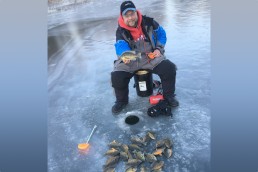Go Ultra-Ultralight for Panfish at First Ice
SHARE THIS POST
I am primarily a walleye fisherman, virtually year-round. But there’s one time of year when I gladly abandon walleyes and pursue something different. That time of year is first ice, and the critters I chase are panfish.
There are two reasons. First, first ice forms in shallow water and it’s almost impossible to get to where the walleyes live traveling atop early ice. You must wait for safe ice, and by then, you’ve lost a lot of fishing time waiting for it. Just as importantly, first ice is excellent for bluegills and crappies, which can be a hoot to catch and excellent in the frying pan.
Typically, first ice forms off the main lake, in the cuts and canals, bays and bayous that surround the main body of water. You can have good, fishable ice while the main lake is still open water. The areas off the main lake are often protected from the wind and generally much shallower.
Whenever I go for bluegills, I like to start shallow—no more than 10 or 12 feet, and preferably even shallower. The ‘gills are in there looking for warmer water and food. And there are generally still green weeds in the shallows, long after the deeper weed beds have started to deteriorate. There’s lots of food in those weedy areas, like small minnows and all manner of invertebrates that relate to the weeds.
Backwater areas are generally smaller, too, so you can cover them thoroughly by hole-hopping rather than looking for a needle in a haystack in deep water.
To me, first-ice bluegill fishing calls for not just ultralight tackle, but ultra-ultralight tackle. (Maybe even ultra-ultra-ultralight tackle.) Start with the line. I use monofilament nylon sewing thread. It probably tests at less than a pound, maybe even a half-pound. The difference between sewing thread and 2-, 3- and 4-pound line is like night and day different.
Bluegills (and crappies, to a little lesser extent) don’t bite. They suck. When they sip on your bait, it swings into their mouths. Heavier line holds it back a little bit. You’re not dealing with walleyes or pike. They’re sucking it in, and I’ve watched them do it in a dark shanty. When they try to suck it in and they don’t get it, they leave.
Because sewing thread is so light and thin, you can use really small teardrops. Those little teardrops look like bugs floating around down there. If you use heavy line, its stiff right to the lure. You’re just lifting it up and down, like you’re jigging for walleyes. On light line, that thing is bouncing around down there. It bends and swims a little. With heavy line, you’re pushing that jig down. With light line, it’s kind of floating down. It looks more natural, and the fish can grab it a lot easier.
Are you enjoying this post?
You can be among the first to get the latest info on where to go, what to use and how to use it!
So, use tiny jigs and tie directly to the line. Don’t put a snap or snap swivel on the line; that just adds weight, inhibiting the movement of the bait and making it harder for the fish to inhale it.
When using ultra-ultralight line, you must use an appropriate rod. My rods are really light, sensitive, limber rods, kind of like noodle rods: really whippy. I don’t use bobbers. I just watch my rod tip. But with the ultra-ultralight rods and line, you can feel the bite. If you’re too freaked out to use sewing thread, then put a little bend in your line and watch that crease. It acts like a spring bobber. But if you use a whippy enough rod, you don’t need a spring bobber; the rod tip serves that function.
Remember, the rod acts as a shock absorber when you’re using light line, just like steelhead fishermen use noodle rods and light line to whip 10-pound (or bigger) fish. You don’t have to worry about breaking off.
My approach is to let the bait fall all the way to the bottom, and then pound the bottom—just like I do when walleye fishing—to kick up the silt. It attracts fish. The fish hear it, feel it and come over to check it out.
Start bringing the bait up, jigging it up a few inches at a time. Work the whole water column; some fish are on the bottom, and some are right up under the ice. Just keep coming up a few inches at a time.
When you get to the top without a bite, let the line drop back to the bottom, but pay attention as the bait is falling. If you catch one on the drop, you have an idea where the fish are. Fish at that level. Don’t waste time once you locate the depth the fish are feeding at.
Get better results from the time you spend fishing. Use information from the pros found in every issue of MidWest Outdoors, available by subscribing on our website.
MWO
SHARE THIS POST
You may also like...
Nothing found.
Did you enjoy this post?
You can be among the first to get the latest info on where to go, what to use and how to use it!
Mark Martin
Mark Martin is a professional walleye tournament angler and instructor with the Ice Fishing School/Vacation series. For more information, check out his website at markmartins.net or fishingvacationschool.com.
